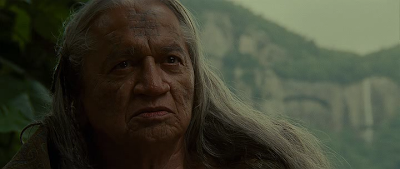Gone ... for good. Well, there are those of us who still live in hope. No body , hence , who knows? But I feel he's gone for good. So good-bye, Lucas.
After watching the thrilling finale of this year's Spooks season I felt upset, moved but grateful, orphaned but gratified. I've had plenty of emotions thanks to Lucas North. I'm sad now and feel in loss but I AM grateful for what I had.
Series 7, October 2008. When Lucas first appeared from that black hood back from the hell of a Russian prison , bedraggled and malnourished, staggering toward Harry Pearce I thought:
"Here we go, the great adventure has started"!
It was bliss: my favourite actor in my favourite series! I couldn't believe I was being that lucky. And it was great, amazing, so intriguing. Lucas 's journey in Spooks was very interesting, full of twists and turns. Complicated and, at times, rather incredible but not when you have Richard Armitage playing that role. He succeeded in making every unbelievable, unpredictable, implausible twist simply possible with his
heartfelt , convincing performances.
I loved Lucas's inscrutability and vulnerability, his coldness and his fragility. That only perceptible, yet indecipherable, mysteriousness was his charm. And then he was cool, smart, brave, generous, loyal, reliable, enterprising, tender, extraordinary, skillful ...

Lucas's journey was the opposite of Guy of Gisborne's : we met the latter as the villain in BBC latest version of Robin Hood's legend but, peeling layer after layer, we discovered his hidden goodness and frailty. Mr North's story was different and reverse. When I guessed what was going to happen to Lucas, long before the new series started, I was so angry ! Almost furious. But then , watching the series, episode after espisode, I just let it be... the emotions and the storyline took hold of me ... stunning series! Gripping. Not perfect, but extremely good . Emotionally involving. After series 7, this latest one is among my best favourites. Spooks 8 , instead, had left me quite disappointed for several reasons.First of all the lack of chemistry between Lucas and that Sarah what-she-was-called. Never seen one of the episodes a second time. Some music fanvids, yes, but never an episode again.
 |
| Lucas North in series 8 |
What was I saying? Yes, Lucas's journey the reverse of Guy's in RH. Peeling layer after layer in this series we are led to discover his hidden dark side. A true Mr Hyde, John Bateman. I still have Richard's "WHAT?" in my ears (
Watch this interview, 4:33, if you don't remember it) . I made it mine when I first heard Vaughn Edwards calling Lucas, "
John"! But then, I just let it be. And it was great. They
deconstructed the character I loved, I let it be and ... enjoyed the show.
My favourite Lucas moments...
1. Yes! Lucas & Elizabeta. Tender, protective, reassuring. He lets her go in the end (series 7, ep. 5) , apparently in order to protect her new quiet life.
2. Episode 6 series 7. Helping the teen and his mother. Wasn't he awesome in that episode? BTW, was he really the son of a minister? Who knows!
3. "Close your eyes. You'll remember". This is another unforgettable scene. Shivering moments.
4. They were tough together. Unbeatable, it seemed. I loved to watch them together. Ros & Lucas. I'll miss them both.
5. "My name isn't ... Lucas North. My name is John ... Bateman". The naked truth. What suffering on both faces . This long confrontation scene between Lucas and Harry is another awesome bit. Richard and Peter Firth were touching in their performances, so convincing!
Lucas: a mystery to us all. I wonder, just like Elizabeta in series 7 episode 2:
"Were you always this cold ... under the skin?
Was the man I knew just a lie?"
I loved Lucas North. Till the very end , against all odds, at any cost. What about you?






















































